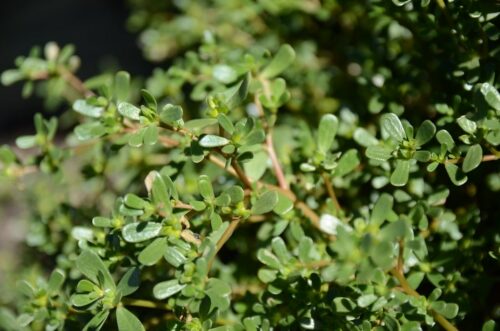Image courtesy of Flickr.
There is a phantom menace in the room—climate change is insidiously altering our lives. Among the direst of threats is worsening droughts: as temperatures rise, surface water evaporation increases, quickly drying soil and diminishing the yield of essential crops. However, a team of Yale researchers has found a potential anti-drought mechanism hidden within the leaves of purslane (Portulaca oleracea), a common succulent that may someday be called the “super plant” of drought.
Photosynthesis involves an important step known as the Calvin cycle, a series of reactions that fix carbon dioxide (CO2) to form sugar. During drought, plants close leaf pores to decrease water loss, preventing CO2 from entering the leaves. The resulting CO2 starvation causes rubisco, the carbon-fixing enzyme of the Calvin cycle, to preferentially bind oxygen. This inefficient process, termed photorespiration, decimates many crops.
However, some plants employ a clever solution: carbon-concentrating mechanisms C4 and Crassulacean acid metabolism (CAM). These pathways recruit enzymes to perform extra steps before the main Calvin cycle, making CO2 readily available so that rubisco can work efficiently without losing resources to photorespiration.
Specifically, C4 allows plants to maintain high photosynthetic efficiency at elevated temperatures, whereas CAM allows for extended survival in dry conditions. To accomplish this, C4 separates initial CO2 fixation from the Calvin cycle spatially between different cell types during the day, while CAM separates these processes temporally between night and day in the same cells.
“But because they’re using the same enzymes, and in C4 they’re expressed in very spatially explicit parts of the leaf during the day, while in CAM they’re expressed at night, it was thought that they couldn’t be compatible. How can you evolve both of these things in the same leaf when you’re recruiting the same enzymes but asking them to do different things?” said Yale’s Erika Edwards, Professor of Ecology and Evolutionary Biology and the principal investigator of the lab which published this research. It appeared to many in the field that integrating these mechanisms in a single plant—an idealized adaptation that could be the best of both worlds—would only occur through spatial isolation.
“But [in purslane] they actually are totally integrated, operating in the same cells,” said Edwards, “and what’s really cool is that during the day, you can get the C4 cycle turning on and doing its thing, and at night have the CAM cycle upregulated in the same cell population using a different set of enzymes. And then, in the two parts of the biochemical cycle that overlap, we discovered that CAM metabolites, the intermediate molecules that it’s making in the pathway, are actually just shunted right into the C4 cycle. So, CAM is actually feeding C4 photosynthesis.”
This revelation opens new ambitions: engineering drought-resistant crop plants that integrate C4, CAM, or both. Rice, for example, is a C3 plant with no resistance adaptations, while corn and sugarcane are C4 plants that could be made to incorporate CAM mechanisms. There are technical challenges to such manipulation, but overcoming them could bring us one step closer to a food-secure future.

